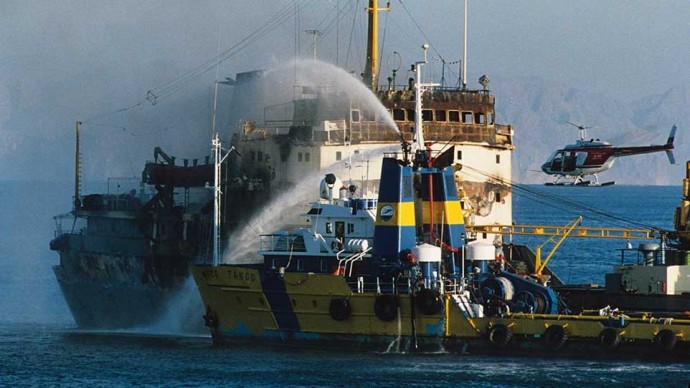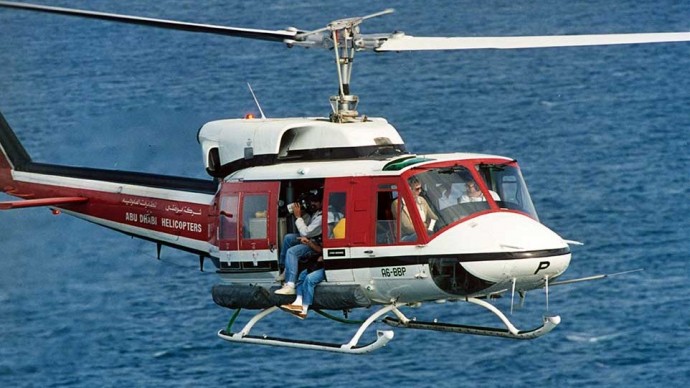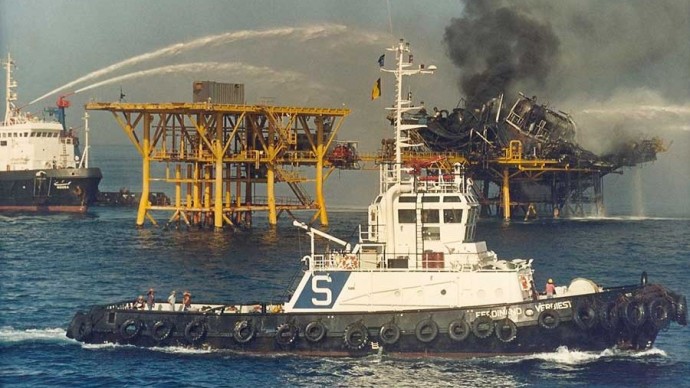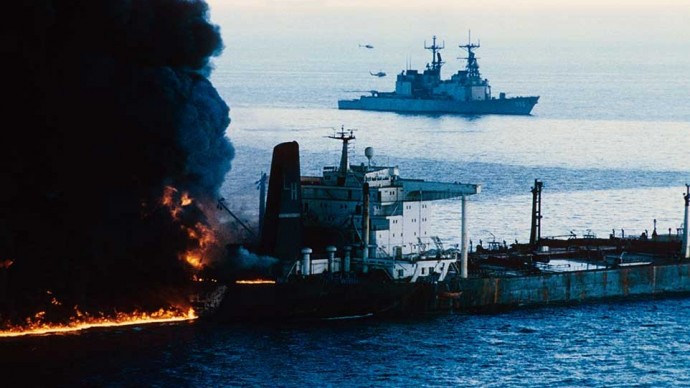
By the autumn of 1987, Iraq was slowly getting the upper hand in the ground war and taking back some of the territory it had lost to Iran earlier in the conflict. In the Gulf waters, however, in an effort to protect commercial ships, 11 nations — most notably the U.S., the Soviet Union, Britain and France – sent navies to the Gulf.
After I arrived in Dubai, my colleague, who I was sent to replace, confessed that the major difficulty in covering the “tanker war” was the high cost of chartering a helicopter. To get around hiring one himself, he made his rounds every morning to the different hotels that house the major American television networks and would try and offer to pay part of the helicopters operational costs in exchange for a ride. For the major networks it was not so much a matter of money, but rather available space on board the chopper. For example, if the correspondent decided not to go at the last minute there could be a seat available. And even if you were lucky enough to get a ride, it didn’t mean that you were going to find anything interesting to photograph.
For my first few days, I chartered a small plane because it was much cheaper than a helicopter, and I could cover greater distances. However, it was far more difficult to take photographs from a plane that at best could circle the area you wanted to focus on. There was also the difficulty of shooting pictures from a tiny opening in the glass window. A helicopter, on the other hand, could hover over an area for as long as you wanted it to and the doors could easily be removed to accommodate more than one person shooting pictures or video. However, since I had just arrived my main concern was to get my name on the wire so the editors could see that I was working.

My first sorties out over the Gulf in a plane were uneventful. I managed to photograph some Soviet warships being resupplied by one of their support ships, and I photographed random unescorted oil tankers transiting the treacherous Hormuz Straits where many of the attacks occurred. But in terms of finding something news worthy, I was unlucky each time I went up.
My biggest problem was not having anyone to tip me off when a U.S. flagged convoy was passing or when the Iranians were attacking a ship. At the time, the agency I worked for had very little representation in the Gulf so the task of finding out information was largely left to me. After hiring a plane for the first week, I decided to take a gamble and go sit in one of the television newsrooms and just wait for something happen. And then when they got word of an attack or convoy passing, I would pray that the correspondent would decide not to go, leaving me to fill the empty seat in the chopper.
After making the rounds with the TV networks, I found that the only one that was interested in cooperating with me on a regular basis was the new kid on the block, Cable News Network (CNN). The CNN crew was staying in the same hotel as me, and they were on a very tight budget. Back then, CNN was a far cry from the multibillion dollar network it is today. They operated on a modest budget and were contemptuously called the “chicken noodle network” by journalists who worked for the more established and wealthier stations ABC, CBS and NBC. Because of their financial restrictions, CNN crews were always looking to share helicopter costs with press photographers from news agencies and magazines. The first taker was the Associated Press photographer, followed by me. This relationship was made official in a contract between the three news agencies and Abu Dhabi Aviation, the helicopter company we were dealing with.
Initially, I was told by my agency that I would be rotated out after a month. However, after I secured the helicopter deal, they decided to keep me in Dubai infinity, which suited me just fine.
We shared the smallest helicopter in the fleet, a Bell 206, and in order to accommodate everyone, we removed all the doors so that we could shoot in all directions. In the beginning, the coverage was somehow chaotic. The first time we arrived at the scene of a stricken ship burning at sea, three of us were yelling out simultaneous instructions to our pilot who was trying to meet our demands while navigating his way around other news helicopters at the scene. After the initial pandemonium, the four of us got into a rhythm that seemed to work. For the next 11 months, until a ceasefire agreement was finally implemented, I spent my days, along with a few other photographers and cameramen, cooped up in a compound monitoring radio traffic for SOS calls or flying out over the Gulf waters in search of U.S. Navy escorted convoys.
On April, 14 1988, the USS Samuel B. Roberts struck a sea mine that blew a five meter hole in the hull causing severe damage and injuring 10 sailors. This was the second incident whereby a U.S. warship had been crippled during the Gulf escort operation. Nearly a year before, an Iraqi fighter jet mistakenly attacked the USS Stark thinking it was an Iran warship, killing 37 sailors. Saddam Hussein later apologized for the incident.

When it was determined the Iranians had sown the sea mine, the Americans retaliated. On April 18, four days after the USS Samuel B.
Roberts hit the mine, the U.S. mounted the largest naval operation since World War II, appropriately named “Operation Praying Mantis,” During the course of one day, the Americans destroyed two oil platforms in the Gulf that were used by the Iranian military to attack ships; sank one Iranian frigate and damaged another killing an untold number of sailors; and sank a number of speed boats which were instrumental in attacking merchant ships.
That day, I was fortunate to be in a helicopter that was equipped with an additional fuel tank. The distance we covered was further than I had ever gone before. When we got to Sirri platform, the second of the two platforms attacked, fire tugboats were trying to extinguish the blaze.
Looking at the bigger picture, April 18 also marked a major turning point in the ground war. The very same day the Americans engaged the Iranians at sea, the Iraqi army took back the strategic Faw Peninsula, which they had lost to the Iranians two years before.
There were two worlds for me back then; one was the “tanker war” raging out at sea and the other was the fantasy life I was leading in Dubai. As close as the two worlds were, it was nearly impossible to tell when sitting on the beach, sipping a cocktail and staring out over the water.



